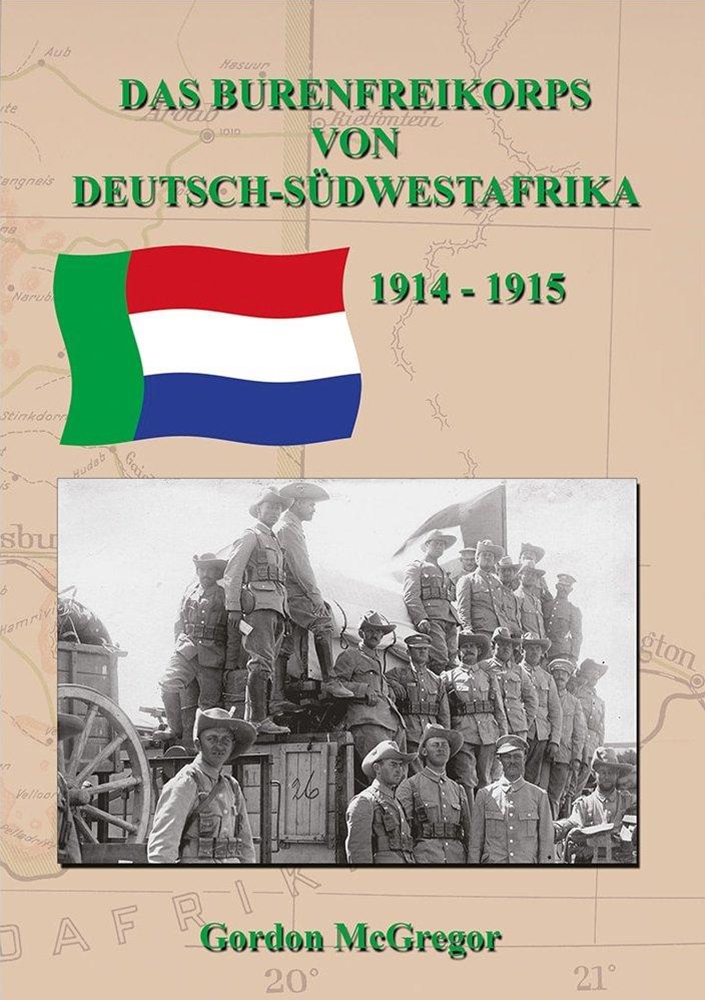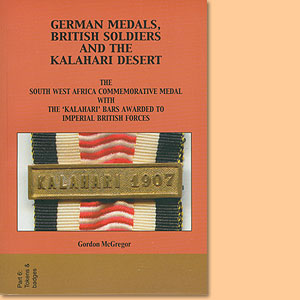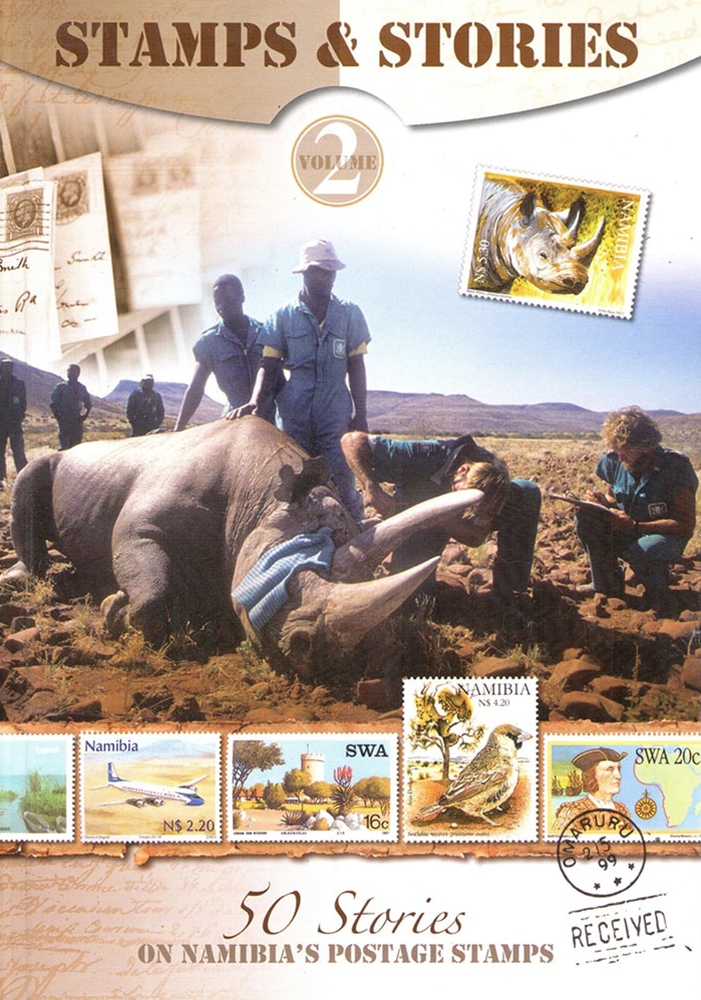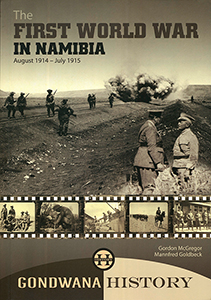Gondwana History: Memorable Moments from Namibia's Past, 6th edition, by Mannfred Goldbeck
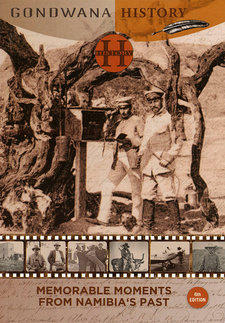
Gondwana History: Memorable Moments from Namibia's Past, 6th edition, by Mannfred Goldbeck. Gondwana History, Vol 6. Nature Investments, Namibia 2015. ISBN 9789994579549 / ISBN 978-99945-79-54-9
Gondwana History: Memorable Moments from Namibia's Past, 6th edition by Mannfred Goldbeck is the last book in the Gondwana History series, and it provides a unique opportunity to extend the most sincere thanks to everybody involved and to its readers.
The Khan copper mine in the Namib Desert
In today's age it is a little known fact that during the German colonial era a copper mine was operational close to the current Rössing uranium mine. Of a once thriving operation with approximately 964 tons of processed copper produced from 32,450 tons of ore only an old mining tunnel and a few ruins remain. The copper was shipped to Germany. Several reports written around 1900 recorded the copper ore in the scenic valley close to the Khan River about 70 kilometres from the coastal town of Swakopmund. Paul Ramdohr wrote in 1938 in the magazine "Zeitschrift fur praktische Geologie" that the geologists Ernst Reuning, Professor Dr. Heinrich Ludwig Lotz and O. Stutzer mentioned the ore body at that time. However, the discoverer of the copper reserves was probably Eduard Pechuel-Loesche (1840-1913), a scientist and geographer from Leipzig, Germany. Pechuel-Loesche travelled widely. From 1884 to 1885 he undertook a journey with his wife through then German South West Africa. The country had just been proclaimed a protected area (Schutzgebiet). D. A. Smith in his 1965 paper "The geology of the area around the Khan and Swakop Rivers" reported that Pechuel-Loesche mentioned the copper reserves in the Khan Mountains in his travel journals. Pechuel-Loesche also painted during his travels and 400 watercolour paintings exist, now kept in the Geographic Seminary in Hamburg, Germany. Research might be worthwhile to see if he also painted while travelling in South West Africa. A box with his travel diaries from that journey still awaits analysis in a collection in Munich. Bruno Simmersbach wrote about the early days of mining in the Namib Desert: "In the Khan Mountains near the railway station Khan in the area of the Colonial Society (Kolonialgesellschaft) the company Spilhaus from Cape Town completed some prospecting works. The results encouraged the company C. Heckmann, Kupfer & Messingwerke to conduct further trials, which unexpectedly resulted in the discovery of a rich ore body. The ore, called bornite (Kupfererz) was found in pinkish-white pegmatite rock veins. The copper grade was about 6 to 7 percent. The Heckmann company in Hutten Street in Duisburg-Hochfeld establised a subsidiary, Khan-Kupfergrube GmbH. In 1908/09 preparations began to establish mining operations, which took seven years. This required long-term planning and extensive capital. The first priority was a sufficient water supply. A well was dug 7 kilometres away in the Khan River Valley, 180 metres lower in altitude. The well provided water reliably throughout operations. Machinery and equipment for the mining operations came from Germany and was installed. A shaft was drilled into the mountain, a transmission belt was put in place as well as a small railway. Contiguous with these installations several brick buildings and houses were constructed. Copper mining began in earnest in May 1914. The copper concentrate was produced on site, which was a technical achievement in those days. The concentrate was shipped to Germany. About 80 Europeans and 400 local workers were employed at the Khan copper mine. All groceries and supplies had to be brought to the mine from Swakopmund. The mining company wanted to build a railway link to the existing Otavi railway line to the Khan station further south. These plans were dropped. Instead, the company built a narrow-gauge link 11 kilometres long northwards to connect with the railway line at Arandis. Sections of the old railway embankment, the shunting area, are still visible today at the Arandis Mountain. The small locomotive huffed and puffed as it pulled the wagons filled with copper concentrate uphill towards Arandis. The return journey back to the Khan copper mine was child's play. [...]
This is an excerpt from Gondwana History: Memorable Moments from Namibia's Past, 6th edition, by Mannfred Goldbeck.
Title: Gondwana History: Memorable Moments from Namibia's Past, 6th edition
Authors: Walter Rusch; Mannfred Goldbeck; Inke Stoldt; Sven-Eric Kanzler; Antje Otto; Gordon McGregor; Ron Swilling; Errol Hurter
Series: Gondwana History, Vol 6
Publisher: Nature Investments
Namibia, 2015
ISBN 9789994579549 / ISBN 978-99945-79-54-9
Softcover, 15 x 21 cm, 111 pages, 85 images, 1 map, English text
Rusch, Walter und Goldbeck, Mannfred und Stoldt, Inke und Kanzler, Sven-Eric und Otto, Antje und McGregor, Gordon und Swilling, Ron und Hurter, Errol im Namibiana-Buchangebot
Gondwana History: Memorable Moments from Namibia's Past, 6th edition
Gondwana History: Memorable Moments from Namibia's Past, 6th edition, is a collection of 30 tales of Namibian history, culture and nature.
Road Tripping Namibia (Mapstudio)
Road Tripping Namibia showcases a selection of 15 iconic road trips, all perfectly manageable in a normal car.
The History of Freemasony in Namibia 1905-2019
The History of Freemasony and of the various Lodges and Chapters in Namibia 1905-2019.
South West African Wheel Tax Badges 1926-1961
The wheel tax metal badge came into existence as a result of Ordinance No. 6 of 1926 of the South West Africa Administration. The last badge was issued in 1961.
The Merit Medal for Combatants in German South West Africa 1892-1918
The Merit Medal for Combatants in German South West Africa 1892-1918 was awarded to members of the native population.
Orden- und Medaillenverleihung für den Feldzug in Deutsch-Südwestafrika 1914-1915
Endlich eine vollständige Namesliste für die Orden- und Medaillenverleihung für den Feldzug in Deutsch-Südwestafrika 1914-1915!
The Equestrian Monument (Reiterdenkmal) 1912-2014
A chronological documentation of reports, newspaper clippings and photos/illustrations related to the Equestrian Monument (Reiterdenkmal) 1912-2014.
Seekrieg in Angra Pequena
Dieses hochinteressante Buch erzählt die wahre Geschichte über den sogenannten Seekrieg in Angra Pequeña (Lüderitzbucht) und was sich 1863 dort tatsächlich zugetragen hat.
Das Reiterdenkmal 1912-2014
Diese chronologische Dokumentation zeigt anhand von Berichten, Artikeln und Fotos die Ereignisse um das Reiterdenkmal in Windhoek, Namibia, im Zeitraum von 1912 bis 2014.
Die Eingeborenen-Passmarken von Deutsch-Südwestafrika
Dieses Standardwerk bietet einen Überblick über die Eingeborenen-Passmarken, die in der Kolonie Deutsch-Südwestafrika verwendet wurden.
Murder at Angra Pequeña
Murder at Angra Pequeña is the true story of an incident that happened in 1863 in South West Africa.
Das Burenfreikorps von Deutsch-Südwestafrika 1914-1915
Das Burenfreikorps von Deutsch-Südwestafrika 1914-1915: Aktivitäten von der Aufstellung des Burenfreikorps bis zu dessen Auflösung.
German Medals, British Soldiers and the Kalahari Desert
The South West Africa Commemorative Medal with the "Kalahari" Bars awarded to The Imperial British Forces
For Valour. The history of the Iron Cross and Wound Badge in German Southwest Africa 1914-1918
For Valour. The history of the Iron Cross and Wound Badge in German Southwest Africa 1914-1918.
The Prisoner of War Tokens of German South West Africa
The Prisoner of War Tokens of German South West Africa: A description and a historical view.
Die Kriegsgefangenenmarken von Deutsch-Südwestafrika
Eine sehr interessante Beschreibung der Kriegsgefangenenmarken von Deutsch-Südwestafrika mit geschichtlichem Abriß.
Journal 59-2011 (Namibia Wissenschaftliche Gesellschaft)
Dies ist die 59. Ausgabe des Journals der Namibia Wissenschaftlichen Gesellschaft von 2011.
Journal 63-2015 (Namibia Scientific Society)
A scientific series published by the Namibia Scientific Society, this is the Journal Nr. 63 from 2015.
Mythos Haar. Ethnographische Photografien aus alten Sammlungen Südwestafrikas
Die Photografien aus dem Band Mythos Haar sind als ethnographische Sammlungen Zeugen verschwindender Kulturen Südwestafrikas.
From Landesmuseum to National Museum of Namibia
100 Years (1907-2007) A chronology of an African Museum
Expelled from a beloved Country
Expelled from a beloved Country is the life story of German Settlers in Southern Namibia between Colonial War and World War I.
Vertrieben von geliebter Erde
Vertrieben von geliebter Erde ist Geschichte zweier Brüder aus Deutschland und der Farm Kairos in Südwestafrika.
Stamps & Stories: 50 Geschichten zu Briefmarken-Motiven Namibias, Band 2
Band 2 der Reihe Stamps & Stories erzählt 50 Geschichten zu den Hintergründen der Briefmarken-Motive Namibias.
Stamps & Stories: 50 Geschichten zu Briefmarken-Motiven Namibias
Die Reihe Stamps and Stories erzählt 50 Geschichten zu den Hintergründen der Entstehung der Briefmarken-Motive Namibias.
Stamps & Stories: 50 Stories of Namibia's Postage Stamps Vol 2
Stamps & Stories: 50 Stories of Namibia's Postage Stamps Vol 2 contains entertaining stories related to the images on Namibian postage stamps.
Stamps & Stories: 50 Stories of Namibia's Postage Stamps Vol 1
Stamps & Stories: 50 Stories of Namibia's Postage Stamps Vol 1 introduces to the postal history of Namibia.
Die Kulturgruppen in Namibias östlicher Sambesi-Region (Ost-Caprivi)
Die Kulturgruppen in Namibias östlicher Sambesi-Region (Ost-Caprivi): Eine historische Perspektive und ein Kapitel über Baobabs.
The First World War in Namibia August 1914 - July 1915
This book commemorates the 100th Anniversary of the beginning of the First World War in Namibia August 1914 - July 1915.
David Levin of Twyfelfontein
David Levin of Twyfelfontein is a nice book on Namibian local history and a farmer's biography.
The People of Namibia's Eastern Zambezi Region (Eastern Caprivi)
This series introduces to history, tribes and culture of the people of Namibia's Eastern Zambezi Region, the former Eastern Caprivi.
Keine Chance: Der Erste Weltkrieg in Namibia August 1914 - Juli 1915
Der Haupttitel 'Keine Chance' steht für die Lage der Schutztruppe in Namibia während des Ersten Weltkrieges von August 1914 bis Juli 1915.
David Levin auf Twyfelfontein
David Levin (1911-1983) war der erste und letzte weiße Farmer auf Twyfelfontein. Dies ist ein interessantes ortsgeschichtliches und biographisches Buch.
Wilde Pferde in der Namibwüste
Wilde Pferde in der Namibwüste ist eine Pferde-Biographie, die bei den frühen Equus-Gruppen ansetzt und ihre Verbreitung südlich der Sahara und insbesondere nach Namibia untersucht.
Wild horses in the Namib Desert
This is a comprehensive book on the wild horses living in the Namib Desert in south-western Namibia.
The first 100 years of State Railways in Namibia
This comprehensive and rare book surveys Namibia's railway history over the past 100 years before 1997.
Gondwana History: Memorable Moments from Namibia's Past, 5th edition
Gondwana History: Memorable Moments from Namibia's Past, 5th edition, is a collection of 30 tales of Namibian history, culture and nature.
Gondwana History: Memorable Moments from Namibia's Past, 4th edition
Gondwana History: Memorable Moments from Namibia's Past, 4th edition, is a collection of 30 tales of Namibian history, culture and nature.
Gondwana History: Memorable Moments from Namibia's Past, 2nd edition
This is the 2nd edition of Gondwana History with thirty memorable moments from Namibia's past times.
Gondwana History: Memorable Moments from Namibia's Past, 1st edition
This is the 1st edition/volume of the history series Gondwana History: Memorable Moments from Namibia's Past.
Journal 61-2013 (Namibia Wissenschaftliche Gesellschaft / Namibia Scientific Society)
Dies ist Band 61 des Journals der Namibia Wissenschaftliche Gesellschaft (Namibia Scientific Society), der 2013 herausgegeben wurde. Die Hauptbeiträge dieser Ausgabe sind in deutscher Sprache gehalten.
Gondwana History. Momentaufnahmen aus der Vergangenheit Namibias, Band 5
Namibia bietet zahllose spannende Episoden, die in der Reihe Gondwana History: Momentaufnahmen aus der Vergangenheit Namibias, nach und nach veröffentlicht werden.
Gondwana History. Momentaufnahmen aus der Vergangenheit Namibias, Band 4
Auch der vierte Band der Reihe Gondwana History fesselt mit zahlreichen kurzen Berichten und Momentaufnahmen aus der Vergangenheit Namibias.
Gondwana History. Momentaufnahmen aus der Vergangenheit Namibias, Band 2
Band 2 aus der Reihe Gondwana History bietet 25 Geschichte als Momentaufnahmen aus der Vergangenheit Namibias.
Gondwana History. Momentaufnahmen aus der Vergangenheit Namibias, Band 1
Die Buchreihe Gondwana History ist eine kurzweilige Sammlung interessanter Momentaufnahmen aus der Vergangenheit Namibias.
Afrikanischer Heimatkalender 1981
Dies ist der 51. Jahrgang Afrikanischer Heimatkalender für das Jahr 1981.
Lüderitzbucht. Damals und gestern
Damals und gestern steht für viele hochinteressante Beiträge, Fotos und Dokumente aus der jüngeren und alten Geschichte der Stadt Lüderitzbucht.
Gondwana History: Memorable Moments from Namibia's Past, 3rd edition
Gondwana History: Memorable Moments from Namibia's Past, 3rd edition, is a collection of 30 tales of Namibian history, culture and nature.
Gondwana History. Momentaufnahmen aus der Vergangenheit Namibias, Band 3
Dies ist der Band 3 aus der Reihe Gondwana History mit weiteren Momentaufnahmen aus der Vergangenheit Namibias.












